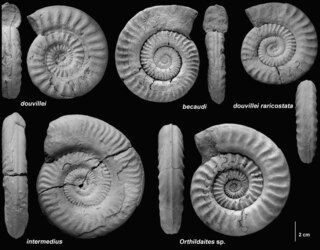Zugodactylites is an extinct genus of ammonite cephalopod from the lower Toarcian epoch of the Lower Jurassic, ammonite zone Fibulatum. Its fossils are found in Europe, Russia and Canada.

Forresteria is an extinct genus of cephalopod belonging to the subclass Ammonoidea. They flourished during the late Turonian and early Coniacian of the Late Cretaceous, and were global in extent. Forresteria alluaudi and Forresteria hobsoni are considered marker fossils for the lower Coniacian in the American West.

Harpoceras is an extinct genus of ammonite belonging to the family Hildoceratidae. These cephalopods existed in the Jurassic period, during the Toarcian age from the Falciferum zone to the Commune subzone of the Bifrons zone. They were fast-moving nektonic carnivores.
Ovaticeras is an extinct genus of cephalopod belonging to the family Hildoceratidae. These cephalopods existed in the Jurassic period, during upper Pliensbachian and lower Toarcian. Its fossils were found in Europe, North Africa and possibly also in Canada and Vietnam. It might have evolved from Harpoceras falciferum and died out without leaving any descendants.

Cleviceras is an extinct genus of cephalopod belonging to the family Hildoceratidae. These cephalopods existed in the Jurassic period, during Toarcian and possibly even uppermost Pliensbachian age. Sometimes, it is considered to be a synonym of Eleganticeras.

Prodactylioceras is genus of ammonite that lived during the Pliensbachian stage of early Jurassic. It has evolved from Reynesocoeloceras, but maybe not directly, but through Bettoniceras. Its fossils were found in Europe, Asia and North America.
Cetonoceras is genus of ammonite that lived during the upper Pliensbachian stage of early Jurassic. Fossils of this genus were found in Italy, France, Spain, Portugal, Hungary and Austria.
Reynesocoeloceras is genus of ammonite that lived during the lower Pliensbachian stage of early Jurassic, ammonite zones Ibex—Davoei.
Peronoceras is genus of ammonite that lived during the middle Toarcian stage of early Jurassic. Members of this genus existed only in Fibulatum Subzone of Bifrons Zone. Their fossils were found in Europe, northern Africa, Asia, North America and South America.
Septimaniceras is genus of ammonites that has probably evolved from Peronoceras and lived during the middle Toarcian stage of early Jurassic. Members of this genus existed from Bifrons Subzone to lower part of Variabilis Subzone. Their fossils were found in France, Hungary and probably also in Austria.
Collina is genus of ammonite that lived during lower to upper Toarcian stage of early Jurassic. Members of this genus existed from Braunianus Subzone to Variabilis Zone. Their fossils were found in Europe, Asia, North America and South America. It has evolved from Mesodactylites.
Catacoeloceras is genus of ammonite that lived during middle to late Toarcian stage of early Jurassic. Members of this genus existed from Crassum Subzone of Bifrons Zone to Variabilis Zone. Their fossils were found in Europe, northern Africa, Asia, North America and South America. It has evolved from Peronoceras, or Porpoceras.
Nodicoeloceras is genus of ammonite that lived during early to middle Toarcian stage of early Jurassic. Members of this genus existed from Exaratum Subzone of Falciferum Zone to Commune subzone of Bifrons Zone. Their fossils were found in Europe, northern Africa, Asia, North America and South America. It has probably evolved from Dactylioceras (Orthodactylites) or Kedonoceras and gave rise to Mesodactylites.
Mesodactylites, which is sometimes considered to be a synonym of Nodicoeloceras is genus of ammonite that lived during early to middle Toarcian stage of early Jurassic. Their fossils were found in southern and central Europe and northern Africa. It has evolved from Nodicoeloceras.
Transicoeloceras, which is sometimes considered to be a synonym of Catacoeloceras is genus of ammonite that lived during Toarcian stage of early Jurassic. Their fossils were found in Hungary, Italy, France, southern Spain and South America. It has evolved from Mesodactylites.
Telodactylites, which is sometimes considered to be a synonym of Porpoceras is genus of ammonite that lived during Toarcian stage of early Jurassic. Their fossils were found in Europe, northern Africa and South America. It has probably evolved from Mesodactylites.
Microdactylites, which is sometimes considered to be a synonym of Dactylioceras, is genus of ammonite that lived during early to middle Toarcian stage of early Jurassic. Their fossils were found in England, France, Italy, Germany and Hungary. Species belonging to this genus were microconchs of Dactylioceras.
Mucrodactylites, which is sometimes considered to be a synonym of Collina, is genus of ammonite that lived during middle to late Toarcian stage of early Jurassic. Their fossils were found in Europe, northern Africa and South America. Species belonging to this genus were probably microconchs of Catacoeloceras. As macroconch of M. mucronatus is considered to be Catacoeloceras raquinianum.
Neolioceratoides is genus of ammonites that lived during the Pliensbachian and Toarcian stages of early Jurassic. It has been considered to be a synonym of Lioceratoides, but cladistic analysis has shown, that this genus is not only valid, but they even belong to different subfamily, as Lioceratoides belongs to Harpoceratinae. Their fossils were found in Europe and northern Africa.

Orthildaites is a genus of ammonites that lived during the lower Toarcian stage of early Jurassic, during Falciferum subzone.




